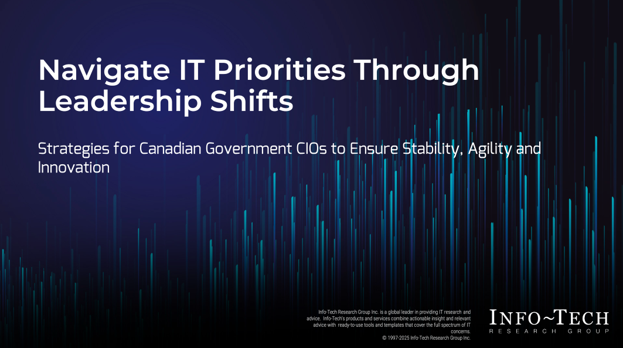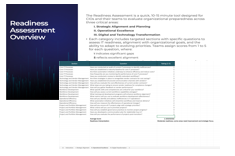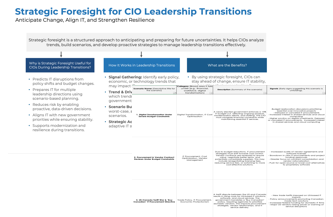Leadership changes disrupt IT priorities, budgets, and service delivery, causing uncertainty and increasing cybersecurity and compliance risks. CIOs must quickly adapt and ensure continuity without compromising long-term modernization efforts.
Our Advice
Critical Insight
By embedding strategic foresight and logical incrementalism into transition planning, CIOs can effectively navigate leadership shifts, turning potential disruptions into opportunities for innovation, modernization, and improved digital services.
Impact and Result
Enhanced stability, sustained innovation, improved alignment with evolving leadership priorities, streamlined processes, reduced cybersecurity risks, optimized budgets, and strengthened IT resilience in government operations.
Navigate Public Sector IT Priorities Through Leadership Shifts
Strategies for Canadian government CIOs to ensure stability, agility, and innovation.
Analyst Perspective
Navigate IT priorities through leadership shifts: Strategies for Canadian government CIOs to ensure stability, agility, and innovation.
Leadership transitions bring both disruption and opportunity for IT. To maintain stability and drive progress, CIOs should:
- Strengthen resilience by proactively assessing risks, reinforcing cybersecurity, and tightening compliance.
- Apply strategic foresight to anticipate policy shifts, budget changes, and evolving political direction.
- Turn foresight into action through logical incrementalism – small, deliberate steps that build momentum and reduce risk.
- Realign IT strategies quickly to support the vision and direction of new leadership.
- Modernize operations to deliver faster, more reliable, citizen-centered digital services.
CIO roles vary across federal, provincial, and municipal governments, but the challenge is shared: how to remain relevant, stable, and forward-looking during political change. This playbook provides practical guidance for all contexts.
Each phase of leadership transition demands a distinct approach:
- Pre-Transition – Scan for risk, engage key players, and prepare for directional shifts.
- Transition – Reassess priorities, adjust budgets, and ensure continuity while aligning with new mandates.
- Post-Transition – Deliver results, modernize platforms, and solidify long-term strategy.
By embedding foresight and executing through logical incrementalism, CIOs can lead with confidence, turn uncertainty into advantage, and position IT as a cornerstone of resilient government.

Patrick Spencer
Research Fellow, Industry Practice
Info-Tech Research Group
Executive Summary
| Your Challenge | Common Obstacles | Info-Tech's Approach |
|
|
Readiness & Risk Assessment – Evaluate organizational, technical, and leadership exposure early to prepare before the transition begins. Foresight & Scenario Planning – Anticipate short-, medium-, and long-term impacts using structured models to guide decisions. Logical Incrementalism – Translate foresight into small, deliberate actions that maintain flexibility and build momentum. Transition Strategy Execution – Apply targeted steps across pre-, during-, and post-transition phases to sustain continuity. Info-Tech Insight IT teams that anticipate change through strategic foresight and move forward through logical incrementalism can turn leadership transitions into opportunities – not disruption. |
Info-Tech Insight
IT teams that anticipate change through strategic foresight and move forward through logical incrementalism can turn leadership transitions into opportunities – not disruption.
Leadership transitions create complex challenges for CIOs
Align IT with shifting policy goals, modernize technology, and sustain critical operations.
Realign IT Priorities
Refocus Efforts – Adjust strategies to meet new priorities across service delivery, economic development, or digital access.
Adopt Emerging Technologies – Use AI, automation, and analytics to improve responsiveness and results.
Enhance Public Services – Deliver accessible, inclusive, and user-friendly digital services that meet changing needs.
Manage Budgets, Teams, and Vendors
Adjust Funding Plans – Respond to shifts in investment timelines or program scope.
Develop Workforce Agility – Upskill staff, retain key talent, and support new ways of working.
Coordinate With Vendors – Update contracts and delivery models to stay aligned with evolving objectives.
Sustain Operations and Strengthen Security
Maintain Service Continuity – Prevent disruption to essential services during leadership changes.
Reinforce Cyber Defenses – Address risks and protect systems throughout periods of transition.
Modernize Infrastructure – Upgrade legacy systems to support greater flexibility, scale, and innovation.
Policy and funding shifts disrupt long-term planning
CIOs must act now to strengthen IT resilience.
1. Governments Are Always Evolving
- Governments continually adapt to economic shifts, policy changes, and external disruptions. Leadership transitions are just one element of this ongoing change.
- Just as tariffs reshape economies and regulations redefine industries, a new administration may introduce policy shifts, budget realignments, and evolving priorities that impact IT.
- These changes can either strengthen or weaken IT resilience, depending on how well CIOs anticipate and respond.
2. Waiting is Not an Option
- Reacting after change occurs is not a viable strategy – resilience must be embedded within IT operations.
- Leadership transitions are not isolated events but are part of an ongoing transformation. CIOs who only respond when a transition happens risk setbacks, loss of funding, and weakened IT influence.
3. CIOs Must Build Resilience
- CIOs must focus on IT resilience by ensuring systems, processes, and teams can withstand and adapt to leadership shifts.
- This requires long-term planning, strong digital foundations, and strategic alignment to government priorities, balancing continuity with innovation.
4. Resilience Must Be Sustained
- Government priorities constantly evolve – IT must keep pace.
- Change is inevitable – waiting increases risk and pressure.
- Prolonged inaction delays modernization and disrupts services.
- CIOs must take proactive steps to stay aligned and resilient.
Adapt quickly to maintain stability and modernize
Transitions bring both risk and opportunity – how CIOs respond matters.
Leadership transitions often shift IT priorities and disrupt plans.
As new leadership takes office, CIOs face changes that can stall modernization, introduce security risks, and create funding uncertainty. CIOs must act early to protect investments, realign priorities, and maintain momentum.
Use transitions to create momentum for improvement.
New leadership may support fresh approaches to technology, process improvement, and service delivery. CIOs who take initiative can align IT with evolving objectives, improve efficiency, and strengthen impact – especially when they move forward incrementally, guided by strategic foresight.
Communicate clearly to build support.
CIOs should engage with incoming leaders, clarify IT's role in meeting new priorities, and secure buy-in for critical initiatives. Strong communication helps build trust, secure funding, and position IT as a driver of service excellence.
Embrace change as a chance to evolve.
CIOs who respond strategically – combining long-term vision with logical incrementalism – can turn uncertainty into opportunity, ensuring continuity while advancing innovation, performance, and long-term value.
Mitigate risks during transitions to protect IT priorities
Failure to adapt can lead to budget cuts, security gaps, and stalled modernization.
Engage early, ensure continuity, and make IT indispensable
Disrupted Services
Misalignment with new priorities can lead to funding cuts or stalled projects, affecting critical government services.
Lost Modernization Opportunities
Without proactive engagement, IT upgrades may be deprioritized, leading to outdated systems and inefficiencies.
Reduced Budget and Support
If CIOs don't effectively communicate IT's value, they risk losing resources and political backing.
Security and Compliance Issues
Delayed or neglected IT governance updates can create cybersecurity vulnerabilities and regulatory noncompliance.
Fragmentation and Shadow IT
A lack of direction may lead agencies to seek independent solutions, increasing inefficiencies and security risks.
Weakened IT Strategy
Without alignment, IT may become reactive rather than strategic, limiting long-term improvements and innovation.
Strategic foresight and logical incrementalism are the solution
Anticipate change, align IT, and adapt step-by-step.
Strategic foresight is a structured approach to anticipating and preparing for future uncertainties, from short-term disruptions to long-term transformations. It helps CIOs identify trends, build scenarios, and develop proactive strategies to manage leadership transitions effectively.
Paired with logical incrementalism, a method of advancing through small, intentional, and adaptable steps, CIOs can respond to shifting government priorities without relying on rigid or high-risk overhauls. Logical incrementalism helps translate foresight into action by enabling measured progress, even when full clarity is not available. It is about thinking strategically while acting pragmatically.
Why are strategic foresight and logical incrementalism useful for CIOs during leadership transitions?
- Predict disruptions from policy or budget shifts and plan early responses.
- Prepare IT for multiple possible leadership directions using flexible strategies.
- Reduce risk by taking small, adaptive steps instead of large-scale overhauls.
- Align IT with evolving political priorities while maintaining core services.
How they work in leadership transitions
- Signal Gathering: Spot early indicators across political, policy, tech, and economic environments.
- Trend & Driver Analysis: Identify what's emerging – and what it means for IT.
- Scenario Building: Explore a range of outcomes and prepare flexible responses.
- Incremental Action Planning: Break strategies into small, low-risk steps that can adjust over time.
- Feedback Loops: Learn and refine after each step to guide the next action.
What are the benefits?
- Enable CIOs to act with confidence, even without full certainty.
- Combine long-term strategic vision with near-term execution.
- Make measurable progress during transitions without overcommitting.
- Support alignment with leadership while maintaining IT momentum.
- Build trust by showing steady, visible action instead of big promises.
Play the Field, Lead the Team: The CIO's Transition Playbook
Government is a lot like football – but with more playbooks, more referees, and higher stakes. When a new administration takes office, it's like a new team owner stepping in. They bring a vision, a mandate, and expectations for performance – but they don't call the plays. They expect results from the field.
Just below them sits the general manager – your deputy minister, city manager, or agency head – who interprets the owner's intent, approves the budget, and oversees execution. The GM works closely with the CIO, the head coach, who leads the IT team, sets the strategy, and ultimately delivers on the mandate.
But the CIO isn't the only coach on the field. Across government, other head coaches (departmental CIOs, agency digital leaders) are running their own systems and strategies. You need alignment, coordination, and shared infrastructure to avoid duplication and deliver impact at scale. You're not just playing a game – you're running in a league of teams, each with different priorities but often playing on the same field.
To succeed, the CIO must draw on the full toolkit
CIO Transition Playbook
START HERE:
Strategic Foresight
- Strategic foresight is your scouting and analytics team. It studies trends, weak signals, and shifts in policy, tech, and citizen expectations. It doesn't give you certainty, but it helps you anticipate, adapt, and position IT for what's coming next.
Exponential IT
- Exponential IT is your offensive philosophy. It's modern, modular, and built for speed. You're not just automating legacy processes – you're launching cloud platforms, embedding AI, and redesigning services to meet evolving user needs. You're not playing for field goals; you're building an offense that can score.
CIO Playbook
- The CIO Playbook is your season-long strategy manual. It defines how to manage portfolios, scale innovation, build governance, and lead transformation across the full enterprise.
CIO Transition Playbook
- In a leadership transition, you need your CIO Transition Playbook – your first-100-day script. It helps you stabilize the team, realign the roadmap, deliver visible wins, and reposition IT under a new political agenda. It's your opening drive strategy when the stakes are high and the room for error is small.
Logical Incrementalism
- Logical incrementalism is your game management system. You manage the clock, take smart risks, and avoid unnecessary turnovers. You build trust through consistent execution – drive by drive, project by project – without overextending the team.
Special Teams
- And then there's special teams – your high-impact, situational plays. These include pilot projects, proofs of concept, and rapid responses to emerging opportunities or risks. Special teams are how you flip the field. A well-timed automation pilot, an early AI use case, or a smart data dashboard can shift momentum, buy you credibility, and reset the tone. When something breaks, special teams recover. When the path forward is unclear, they test and adapt. They don't run the game – but they often change it.
In this game, the rules change often, the ownership rotates, and the fans demand more every year.
But the CIO, as head coach, holds the huddle. With foresight to read the field, Exponential IT to drive transformation, incrementalism to manage the clock, and playbooks to guide action – plus special teams ready to strike – the CIO can lead through any transition, build trust fast, and run a system that wins, no matter who's in the owner's box.
CIO Transition Playbook for Government CIOs
Align IT, manage risks, and modernize.
Strategic Focus
I. Strategic IT Governance for Government CIOs
II. IT Resilience and Risk Management Strategy
Operational Focus
III. Digital Modernization Strategies for Government IT
IV. Modernizing IT for Better Public Services
Key Insight
IT must remain stable, strategically aligned, and resilient during leadership transitions while preparing for long-term modernization and innovation.
CIO Transition Playbook
Leading IT Through Change
The CIO Transition Playbook is a practical guide for Canadian government IT leaders navigating political leadership change. It helps CIOs maintain stability while adjusting IT priorities to new mandates – supporting resilience, agility, modernization, and service continuity.
This playbook equips CIOs with targeted, actionable "plays" to run during the Pre-Transition, Transition, and Post-Transition periods. Each play represents a logical incremental step, grounded in strategic foresight, to help government IT leaders stabilize, align, and shape change – without overreaching or waiting for perfect clarity.
Built around four pillars and 19 practical components, the playbook provides the building blocks for CIOs to respond to leadership transitions through strategic planning, stakeholder engagement, modernization, and risk management. These components can be combined into targeted "plays" that help realign budgets, adapt IT priorities, improve service delivery, strengthen cybersecurity, upgrade infrastructure, and build workforce agility.
By following this approach, CIOs can reduce disruption, align with new leadership priorities, and make IT a key enabler of public sector transformation. The playbook is adaptable to organizations at any maturity level and supports both immediate responses and long-term value.
Info-Tech's methodology to implement the CIO Transition Playbook
| Phase Steps | 1. Pre-Transition – Prepare | 2. Transition – Realign | 3. Post-Transition – Implement & Stabilize | 4. Identify Outcomes and Next Steps |
|
1.1 Assess IT readiness and leadership priorities. 1.2 Identify key stakeholders and align IT with government objectives. 1.3 Conduct strategic foresight and scenario planning. |
2.1 Optimize IT services and vendor management. 2.2 Adjust IT budgets and realign workforce. 2.3 Strengthen cybersecurity resilience. |
3.1 Upgrade legacy IT and modernize services. 3.2 Enhance digital service delivery and inter-agency collaboration. 3.3 Establish long-term IT governance structures. |
4,1 Conduct post-transition debrief and performance assessment. 4.2 Develop a long-term IT modernization roadmap. 4.3 Apply lessons learned for long-term resilience. |
|
| Phase Outcomes |
|
|
|
|
Insight summary
A transition is not just a leadership change – it's an operational shift.
Leadership transitions bring shifts in priorities, funding, and structure. Treat them as ongoing, strategic adjustments that require IT to stay aligned, flexible, and ready to adapt.
IT moves at the speed of execution, not intention.
Even well-designed strategies stall when slowed by procurement, policy delays, or poor coordination. Use readiness assessments and scenario planning to spot roadblocks – and act before they stall progress.
Agility keeps IT on course – rigid plans increase risk.
Static roadmaps break down under new funding models or shifting expectations. Build flexibility into delivery, investment, and staffing so IT can adjust in real time.
Setbacks don't signal failure – recovery proves strength.
Service gaps or delays are common during transitions. What matters is how quickly IT responds. Apply lessons, stabilize operations, and reinforce IT's role in driving outcomes.
Turn transition turbulence into long-term resilience.
Every transition is a chance to evolve. Use it to modernize, strengthen institutional agility, and build lasting readiness through small, intentional steps.
Key Deliverables

Your organization's guide to aligning IT strategies, optimizing resources, and building actionable frameworks for effective leadership transitions and sustainable operational success.
Navigate IT priorities through leadership shifts
Each step of this playbook is accompanied by supporting deliverables to help you accomplish your goals.
Transition Readiness Assessment For Canadian Government Tool
Use Info-Tech's Transition Readiness Assessment For Canadian Government Tool to evaluate your organization's preparedness across strategic alignment, operational excellence, and digital transformation. The tool delivers actionable insights to help you identify gaps, prioritize focus areas, and take targeted steps toward a smooth leadership transition. By supporting informed, incremental action, it enables IT leaders to align with new priorities while sustaining performance and minimizing disruption.

The Strategic Foresight Tool helps CIOs anticipate and navigate leadership transitions by modeling potential risks, trends, and strategic IT responses. By using scenario-based planning, it enables proactive decision-making, aligning IT investments with shifting government priorities while ensuring stability, resilience, and modernization.

Info-Tech offers various levels of support to best suit your needs
| DIY Toolkit | Guided Implementation | Workshop | Executive & Technical Counseling | Consulting |
|---|---|---|---|---|
| "Our team has already made this critical project a priority, and we have the time and capability, but some guidance along the way would be helpful." | "Our team knows that we need to fix a process, but we need assistance to determine where to focus. Some check-ins along the way would help keep us on track." | "We need to hit the ground running and get this project kicked off immediately. Our team has the ability to take this over once we get a framework and strategy in place." | "Our team and processes are maturing; however, to expedite the journey we'll need a seasoned practitioner to coach and validate approaches, deliverables, and opportunities." | "Our team does not have the time or the knowledge to take this project on. We need assistance through the entirety of this project." |
Diagnostics and consistent frameworks are used throughout all five options.
DIY Toolkit: 30-Day Rapid Response Plan For Leadership Transitions
This DIY toolkit provides CIOs and their teams with structured, self-guided steps during unexpected leadership transitions. It leverages a straightforward playbook across Pre-Transition, Transition, and Post-Transition phases, enabling your internal team to independently maintain stability, alignment, and momentum.
| Day Range | Playbook Phase | Strategic Focus | Key Actions |
| Days 1–3 | Pre-Transition | Situational Awareness | Internally review public statements and budget risks and potential shifts. Assign internal leads to impact assessment and stakeholder mapping. |
| Days 4-7 | Pre-Transition | Risk & Dependency Scan | Perform internal assessment of high-risk services, vendor contracts, and active projects. Identify exposures (e.g. funding gaps, critical dependencies). Pause nonessential initiatives. |
| Days 8-14 | Transition | Strategic Positioning | Engage internally to document IT priorities, risks, service performance, and major projects. Prepare clear internal communications to define short-term alignment. |
| Days 15-21 | Transition | Scenario Recalibration | Review and adjust strategic assumptions and scenarios based on the leadership transition. Internally reprioritize initiatives and brief senior management. |
| Days 22-30 | Post-Transition | Stabilize & Re-engage | Update internal communication across teams. Confirm continuity plans and stakeholder engagement. Begin revising the IT roadmap internally and prepare inputs for upcoming governance and budget cycles. |
Use this plan independently or integrate it into your existing strategic foresight processes for ongoing transition readiness.
Guided Implementation
What does a typical CTP GI on this topic look like?
| Phase 1 Pre-Transition: Prepare |
Phase 2 Transition: Realign |
Phase 3 Establish Leadership Transition Readiness |
|---|---|---|
|
Call #1: Assess IT readiness and identify leadership priorities. Call #2: Engage stakeholders to align IT with government objectives. |
Call #3: Optimize IT services and vendor management. Call #4: Adjust IT budgets and realign workforce for leadership changes. Call #5: Strengthen cybersecurity and risk management strategies. |
Call #6: Implement modernization initiatives and upgrade legacy IT. Call #7: Enhance digital services and scale government-wide IT collaboration. |
A Guided Implementation (GI) is a series of calls with an Info-Tech analyst to help implement our best practices in your organization.
A CIO Transition Playbook (CTP) GI typically includes 6 to 10 calls over 3 to 6 months to ensure IT stability, alignment, and modernization.
Leverage skilled facilitation
Info-Tech Research Group provides leadership transition playbook (LTP) facilitation through its workshop product.
To maximize the effectiveness of playbook exercises, engaging a skilled facilitator with expertise in leadership transitions ensures smooth execution and actionable outcomes.
Their expertise can help:
- Strategic foresight & scenario planning: Guiding participants through structured transition exercises to anticipate IT and leadership challenges.
- Interactive engagement: Driving discussions that align IT with evolving government priorities.
- Stakeholder alignment: Ensuring key participants remain engaged and aligned with transition objectives.
- Best practices & risk mitigation: Sharing insights on IT resilience, policy adaptation, and operational continuity during leadership shifts.
By leveraging expert facilitation, CIOs can enhance strategic alignment, mitigate transition risks, and ensure a smooth adaptation to leadership changes.
